Zone of the Enders: how Konami remade its own HD remake
Digital Foundry on how The Second Runner finally got the remastering treatment it deserved.
Video games are in a unique position as a medium when it comes to restoration and reproduction. Unlike other major forms of entertainment, such as music and film, games have the inherent capacity to be dramatically improved upon without compromising the original vision - hence the arrival of HD re-releases for modern consoles. At their best, these compilations allow us to preserve classic games and experience them in a way that was previously unattainable. Unfortunately, even the best intentions often fall prey to poor business decisions and result in collections which fall short. Zone of the Enders HD Collection - released almost one full year ago - was one such release.
Comparable to the shoddy work we received in the Silent Hill HD Collection, the ZOE remasters were saddled with an unplayably low frame-rate and an inaccurate presentation which didn't respect the look of the original games. High Voltage Software, the company responsible for this iteration, failed to meet, let alone exceed the original PlayStation 2 version of the game and many were concerned that it would be left at that. After all, Konami never fully addressed the problems with Silent Hill, so few expected them to bother improving things here. Perhaps as a result of a fan backlash or even as testament to how much Kojima Productions cares about their products, it was quietly revealed this past May that a patch was in the works to repair the original release.
What makes this situation unique is the shift in development duties from High Voltage Software to the Japanese studio HexaDrive - a small company formed by a number of ex-Capcom R&D employees. Previously responsible for the HD releases of Rez and Okami, HexaDrive was challenged with fixing a codebase which had passed through multiple teams across multiple platforms in two different countries. However, the improvement is dramatic thanks to the development of an entirely new renderer designed to take full advantage of the PlayStation 3 which gives the Kojima fanbase the respect it deserves - up to a point. Owing to budgetary issues, only Zone of the Enders: The Second Runner received this treatment and even then it's only the PS3 version that benefits - the Xbox 360 game was not updated, and the original ZOE remains untouched on both platforms.
"The patch finally treats the game - and its fans - with the respect they deserve, but we remain mystified as to why these HD remasters were released in such a state to begin with."
So what went wrong with the original HD release? Performance is by far and away the most significant issue with the frame-rate averaging around 30fps while dips below 20fps appear regularly. V-sync is fully engaged, but the lack of frame skipping results in the game operating at 50 per cent speed (or less) the vast majority of the time. In addition, image quality is limited by a resolution of just 1280x720 with no anti-aliasing, while alpha effects were rendered at a low resolution, textures suffered from in-surface colour banding, depth of field was mostly removed, shading was often inaccurate, and HUD elements were stretched. Remarkably, High Voltage not only failed to enhance the game, it also failed to match the original PlayStation 2 version.
Unlike many modern games, the PlayStation 2 titles developed by Kojima Productions do not make use of frame skipping, where the speed of the action is decoupled from the frame-rate. Each of its games ties gameplay speed directly to engine performance, so a failure to reach the intended performance level results in a corresponding loss of game speed. In order to help alleviate this problem, the engine drops v-sync under stress, not unlike a number of modern games - techniques such as triple-buffering were not available to use on PlayStation 2 as a result of memory constraints. Games from this era typically handled performance drops by either disengaging vertical sync, as with ZOE 2, or simply dropping to a frame-rate evenly divisible by 60Hz (which, in this case, would have resulted in a jump from 60fps to 30fps had the developers not employed the use of soft v-sync). The HD release works in much the same way and is the primary reason why the initial HD release feels almost unplayable - it almost never reaches full speed!
The primary focus of this patch, then, was clearly performance. The patched version now runs very close to its target 60fps in even the most demanding scenes, with v-sync engaged at all times. This level of performance exceeds both the original HD release and the original PlayStation 2 version, though cut-scene performance sees less of an increase, with the original version occasionally besting the updated release (at the expense of visual quality). One of the key changes implemented by HexaDrive to solve the performance problem is the utilisation of the PlayStation 3's SPUs to handle the workload previously designed for PlayStation 2's vector units. ZOE 2 pushed the PlayStation 2 to its limits and the RSX simply doesn't have the muscle on its own to power through it without help. HexaDrive balanced performance across the entire system, including the SPUs, in order to avoid bottlenecks, resulting in a 10x increase in performance across the board.

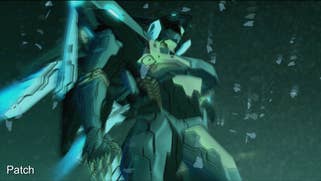
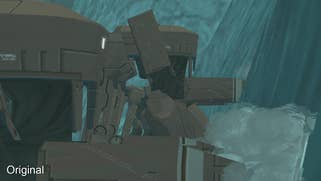
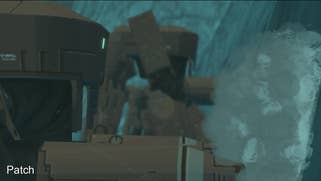
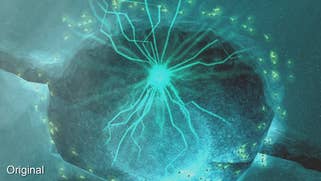
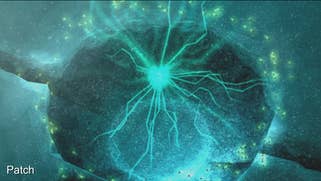

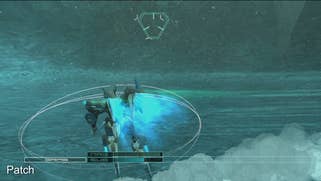
Freeing up the RSX also allows for an increase in image quality as well as frame-rate. HexaDrive has taken a three pronged approach to image quality starting with an output resolution of 1080p complete with higher resolution HUD, text, and menu elements. In-game we see 3D elements rendered internally at a resolution of 1280x1080 with FXAA used to smooth out aliasing. Nvidia's post-process effect was selected as a result of its speed and the game's reliance on alpha test transparency, which doesn't play nicely with standard MSAA. On the flipside, 32x MSAA was used specifically for the display of wireframe elements which do not work well with FXAA. While we would have liked to have seen the in-game visuals rendered at 1920x1080, the results still manage to provide a smooth and clean image that meshes perfectly with the games aesthetic and it still represents an extra 50 per cent boost in detail over High Voltage's initial efforts.
Another hallmark of the series is its heavy usage of particles and alpha effects. Laser trails, explosions, and smoke are pushed to the breaking point on PlayStation 2 requiring the use of a lower resolution alpha buffer. This same technique is also employed in the original HD release producing even more noticeably chunky effects as a result of the higher resolution. Such effects are among the most expensive on current generation consoles, particularly the PlayStation 3, so it's surprising to find the updated release now rendering alpha effects at full resolution. Particle density is also restored to match the original PS2 version, which was also drastically reduced in the initial HD release.
Another core focus of this patch concerns matching the visual effects work seen in the PS2 original as closely as possible. To that end we find that textures originally exhibiting colour banding are cleaned up and corrected to match the PS2 release. PS2 games were often limited to 8-bit palette textures as a result of memory limitations and no longer have proper support on modern hardware. HexaDrive has implemented a means to properly emulate the appearance of such textures on modern hardware allowing for smoother blending of colours. It's a detail that is missing in a number of other PlayStation 2 ports going all the way back to the original Xbox release of Metal Gear Solid 2.
In addition, various on-screen elements including the map display are properly adjusted for 16:9 where previously they were stretched. The appearance of fog, shading and bloom lighting are all adjusted to more closely match the original PS2 version as well. While subtle differences remain between the PS2 release and this updated HD release, the overall appearance of the game is much more accurate than it was previously.
Another important visual effect missing from the original HD release is depth of field. Kojima games are known for their cinematic quality and depth of field plays a large role in this. Going back as far as the original Metal Gear Solid we see varying implementations of this cinematic effect, so it's safe to say that its removal is surprising. Depth of field is rendered at a lower resolution on PlayStation 2 similar to other alpha effects so perhaps, as a result of the original implementation, the effect simply didn't play well at 1280x720. Version 2.0 not only reintroduces depth of field but does so using modern techniques. The result is a smooth, higher resolution effect complete with bokeh. The effect is most prominent throughout the games cinema sequences but it is also used to enhance numerous gameplay sequences as well.
It's clear that a lot of work was put into this patch, which finally treats the game - and its fans - with the respect they deserve, but we remain mystified as to why these HD remasters were released in such a shocking state to begin with. Bearing in mind the quality of the original ZOE HD release and its Silent Hill counterpart, we can only assume that budgets took priority over properly remastering these games in a high definition format. That said, we also see that lessons can be learned and perhaps this investment will help to avoid such costly mistakes in the future. With the next generation of consoles on the horizon, the days of porting PlayStation 2 software are no doubt numbered but it's a safe bet that we'll see PS3 and 360 games ported to their successors somewhere down the line. Let's hope that the example of Zone of the Enders will inspire publishers to get their future remasters right the first time - after all, at the core, these releases are fan service, and nostalgia-fuelled gamers are a clearly a highly discerning bunch.



